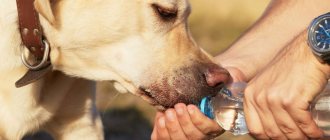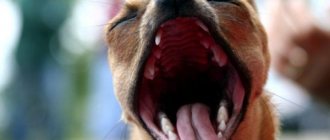- Excessive dog peeing as a normal reflex
- Situations when a dog drinks a lot and pees as a result of illness
What is the reason for frequent bouts of thirst in a dog and frequent urination?
Many owners have to deal with the problem when the dog drinks a lot and urinates a lot, which can be due to either a natural reflex or the development of dangerous diseases.
To distinguish one from the other, you can observe the behavior of your pet and, based on its characteristic signs, recognize whether it is a disease or simply a protective function of the body to some irritant. The information below will help you understand this issue, as it gives a detailed idea of the dog’s unusual behavior.
How much water does a dog drink in normal condition?
When it comes to a dog’s increased fluid consumption, it is necessary, first of all, to define the concept of normal. There are no absolute figures on this matter, since the body’s need for water is determined by several factors, including:
- the size of the animal, and this relationship is a little more complex than a simple proportion, defined as the volume of liquid per kilogram of weight;
- age (puppies in their first year of life need approximately 2–3 times more water than adults);
- type of food (natural or wet food contains a large amount of water, but if the dog’s diet consists of dry food, the animal needs much more liquid);
- ambient temperature (dogs, like people, cool their bodies in the heat by secreting sweat; accordingly, at this time their need for fluid increases), etc.
Important! The average rate of water consumption for a dog is 40–60 ml per 1 kg of body weight, while a person, according to the official position of the World Health Organization, needs only 30 ml of liquid for the same unit of calculation. It is characteristic that the water content in the body of a human and a dog is the same - approximately 60%.
An interesting pattern is that the lower limit of the average accepted norm given above is suitable for representatives of large breeds, while the upper limit is valid for small and dwarf dogs. The fact is that the urine of small breeds of dogs contains an increased amount of acid, which is why such animals very often suffer from various pathologies of the genitourinary system. In order to reduce the acidity of urine and, accordingly, reduce the load on the kidneys, it is necessary to provide your pet with maximum fluid intake during the day.
General information about the disease
Over the past few years, public health has reported an increase in the incidence of diabetes mellitus among children and adults in the Russian Federation. At the same time, the rate of the same disease among dogs has more than tripled since 1970, so today, on average, the sweet disease affects one animal in every 160 dogs. However, while the “human” form of the disease can be further maintained through diet, in dogs, diabetes is a lifelong condition that is not controlled in any way through diet.
Type 1 diabetes, which occurs in dogs, occurs when the body is unable to produce enough of the hormone insulin needed to metabolize carbohydrates, the main source of energy for cells. The reason for this, as a rule, is the inability of the pancreas to produce the required amount of the hormone. In addition, dogs can develop so-called gestational diabetes, which occurs mainly during pregnancy.
Type 2 diabetes mellitus is the result of resistance (resistance, not accepting) insulin, which is often associated with diet and obesity. This form is most common in humans and felines, but there is no evidence yet that this variant of the disease occurs in dogs.
Why does a dog drink a lot of water and urinate frequently?
There should always be clean and fresh water in the dog's drinking bowl so that the animal can quench its thirst at any time of the day or night. Our little brothers tolerate a lack of fluid much worse than humans, therefore, as a general rule, there is never too much fluid. At the same time, if a pet drinks greedily and often, while constantly asking to pee, this situation can cause an imbalance in the electrolyte balance in the body, since not only water, but also mineral salts dissolved in it are excreted with excess urine. In addition, severe thirst in some cases is a symptom of a serious illness, which is why this phenomenon should not be ignored.
Important! The state of increased thirst, which decreases only after drinking a clearly excessive amount of liquid, in medical science is called
“polydipsia ”, from the ancient Greek πολύς - large amount, multitude, and δίψα - thirst.
And yet, before contacting a doctor, the owner should take a closer look at the pet’s condition in order, on the one hand, to exclude possible natural causes of the dog’s changed behavior, and on the other, to be able to more informatively describe the clinical picture to the specialist, which will greatly help with the diagnosis. .
Natural causes
There are a huge number of absolutely natural reasons, depending on which a dog may drink more or less than the average norm. Therefore, even after noticing that the pet’s fluid intake has increased compared to usual, the owner should analyze whether anything has changed in the conditions of keeping the dog or in its life in general.
In particular, factors that can increase thirst include:
- temperature and humidity in the room where the animal is kept, as well as outside during walks (the warmer and drier the air, the more fluid the dog needs);
- coat length (shaggy and fluffy pets, for obvious reasons, tolerate heat worse than their short-haired counterparts);
- increased content of dust in the air, as well as various chemical emissions that irritate the mucous membranes of the oral cavity and cause a natural desire to moisten them with water);
- consistency, chemical composition and energy value of the diet (in addition to the already mentioned example with dry food, the amount of salts, sugar and proteins in the food is also important);
- physical activity (in young dogs who spend a lot of time playing outdoor games, metabolic processes in the body proceed much faster, and accordingly, they need more water);
- taking certain medications, as well as undergoing general anesthesia (the active substances of drugs are removed from the body in the urine, so in some cases the animal’s natural desire to drink more liquid should be suppressed by the owner in order for the treatment to work);
- physique (muscular dogs, as well as overweight animals, consume more fluid, since both muscle and fat tissue contain water);
- estrus, pregnancy and lactation in bitches, which is associated with an accelerated metabolic process at this time, as well as additional fluid consumption for feeding puppies.
As a dog ages, the amount of fluid it consumes during the day usually remains the same, but the frequency of trips to the water bottle increases, which may give the owner the impression that the pet is drinking more. In fact, the animal's bladder, weakened with age, begins to retain moisture poorly, so the dog tries to drink more often, but in small portions.
All of the above conditions are considered natural, and nothing needs to be done in this case. However, it should be understood that we are not talking about polydipsia here, but simply about increased thirst, i.e. in such cases the dog drinks more than usual, but not abnormally much.
Did you know? A dog's sweat glands are located on the pads of their paws, which, due to their small area, is absolutely not enough to cool the body in extreme heat. Sticking out the tongue helps solve the problem - saliva actively evaporates from the large surface, thereby reducing body temperature.
Kidney or urinary system problems
Most often, polydipsia is associated with pathological processes in the kidneys and urinary system. It is these problems that are indicated by additional symptoms such as:
- difficulty urinating (due to the fact that it is painful for the dog to pee, it can whine pitifully, raising its paw, but at the same time reflexively hold urine, preventing it from pouring out);
- urinary incontinence, or enuresis (the animal begins to pee at night or early in the morning, not being able to wait until it’s time to go for a walk);
- a change in the color of urine to a darker color, the appearance of any foreign impurities in it - mucus, blood, pus;
- a state of general depression, loss of appetite, exhaustion.
A similar clinical picture is typical for many diseases of the kidneys, bladder, ureters and urethra - cystitis, pyelonephritis, glomerulonephritis, interstitial nephritis, nephrosis, nephrosclerosis, polycystic kidney disease, urolithiasis, etc.
Diabetes
Another likely cause of polydipsia in dogs is related to diabetes. This disease mainly affects middle-aged (from the fifth year of life) and elderly animals, and females, according to statistics, are 2 times more susceptible to diabetes than males.
The pathology is incurable and is characterized by an increased level of glucose in the blood, which occurs due to problems with the production of insulin or with the process of its absorption by the body.
Did you know? In London, at a special exhibition, guests are invited to try
Gilpin Family Whiskey, an elite single malt alcoholic drink, the raw material for which is the urine of elderly people with type 2 diabetes.
The author of the original idea is British designer James Gilpin, who, however, does not intend to launch his products into mass production and, rather, views them as an art project. There are 4 types of diabetes that a dog can develop:
- insulin-dependent (type 1) - the most common, is an autoimmune pathology, inherited and characterized by insufficient insulin production by the pancreas;
- insulin-independent (type 2) - in this case, a sufficient or even excess amount of insulin is produced in the animal’s body, but the immune system blocks its absorption;
- transient (transient) - occurs as a side effect of another disease, for example, pancreatitis;
- secondary (gestational) - this pathology is hormonal in nature and can, for example, develop in bitches during pregnancy or premenopause (diestrus).
Characteristic symptoms of diabetes, in addition to thirst and frequent, sometimes painful, urination, are dehydration, excess weight (sometimes the disease, on the contrary, causes exhaustion), lethargy, vision problems, in particular, the development of cataracts.
Pyometra
Pyometra, or purulent endometritis, is an inflammatory process of the uterine cavity, which, in the absence of adequate treatment, ends in death. It can develop in bitches of any age; the only guarantee against such a problem is complete sterilization with removal of the uterus and both ovaries. Risk factors include the use of hormonal drugs designed to block the manifestations of estrus (“Sex Barrier”, “Stop Sex”, etc.), as well as estrogen termination of pregnancy.
Depending on the form of the pathology (closed or open), the pus that forms in the uterine cavity comes out along with the blood or accumulates in the cavity of the genital organ, which significantly aggravates the general condition of the animal: it may become difficult for the dog not only to urinate, but even to walk and breathe.
Did you know? In 2016, a Maremmo-Abruzzese shepherd named Stella, living in the USA, gave birth to 17 puppies, breaking a world record. He did not last long, however: in the fall of the same year, the Central Asian shepherd dog Erika from Russia gave birth to 19 cubs.
Pyometra is a disease of a bacterial nature. During estrus or childbirth, when the animal’s body is weakened due to bacterial imbalance, microbes penetrate through the open cervix into the uterine cavity, and when, under the influence of progesterone, the uterus closes, the most favorable conditions are created for pathogens, and they begin to actively multiply, which is greatly facilitated by reduced resistance of the inner layer of the uterus to infection. Toxins produced by bacteria during their life processes lead to rapid intoxication of the body and death of the animal.
Piroplasmosis
If pyometra is a purely “female” problem, then piroplasmosis (an alternative name is babesiosis) is an infectious disease that can affect any dog, regardless of gender, age or breed. It has been noticed, however, that in purebred animals, as well as in puppies and elderly dogs, piroplasmosis occurs in a more severe form, which is apparently due to insufficiently strong immunity.
The causative agent of the disease is a single-celled pigmentless blood parasite Piroplasma canis, genus Piroplasma Patton, family Babesiidae Poche, and this pest enters the donor’s blood thanks to its vectors - ixodid ticks.
As a result of the action of the pathogen in the body, red blood cells are destroyed, and then the body is intoxicated with the breakdown products of hemoglobin.
Problems with urination and increased thirst are far from the main symptoms of piroplasmosis. The disease is also characterized by:
- increased body temperature;
- change in urine color to very dark, almost black;
- pallor or yellowness of the mucous membranes;
- loss of appetite, weakness, exhaustion, lack of reaction to others.
Find out more about how to treat piroplasmosis in dogs.
Other diseases
In addition to the pathologies listed above, polydipsia and frequent urination can be characteristic of a number of other diseases and abnormal conditions. In particular, this list can be supplemented with the following possible reasons:
- Food poisoning. Due to diarrhea and the dehydration process that develops in connection with this, the animal’s body requires an increased amount of fluid, because it is with it that pathogens destroyed by the immune system are brought out - pathogenic microflora, toxins, etc.
- Thyroid dysfunction and other diseases of the endocrine system.
- Increased body temperature. Hyperthermia, which occurs as a response of the immune system to any inflammatory process in the body (including those associated with a bacterial or viral infection), as well as some other diseases, for example, pancreatitis, ulcers, etc., provokes a response launch of the internal cooling system - abundant sweating A lot of fluid evaporates with sweat, and its reserves need to be replenished.
- Hypercalcemia is a serious condition associated with an increased level of calcium in the blood of an animal.
- Liver diseases, in particular cholangitis, hepatitis or liver failure.
- Ectopic ureter is a congenital pathology characterized by chronic urinary incontinence.
- Severe nervous disorder and other problems of psychogenic origin.
- Spinal injury. In particular, pinching of certain nerve endings sometimes leads to increased thirst.
- Age-related failure of internal organs - kidneys or liver. In the early stages it is characterized by severe vomiting and a pronounced putrid odor from the mouth, later hypothermia, paralysis and death develop.
- Some cancers.
Features of prevention
The genetic predisposition of some dogs to diabetes insipidus and other metabolic and kidney pathologies cannot be eliminated. It is possible to prevent inflammatory kidney disease in dogs - glomerulonephritis, pyelonephritis:
- proper feeding;
- avoid hypothermia;
- use medications only as prescribed by a veterinarian;
- prevent exposure to household and other poisons;
- promptly treat diseases of the urinary system.
All systems in an animal's body are connected. Therefore, cardiac, respiratory or liver failure often leads to a deterioration in the functioning of the excretory system - the dog urinates on itself and drinks much more. Preventing diseases of other organs will save your pet from kidney damage. Vaccinations and treatments against parasites must be carried out according to the plan. All pathologies must be eliminated at an early stage, and after treatment a course of rehabilitation must be carried out.
Proper feeding is of great importance for the health of your pet. Excess protein and salts in the feed leads to disruption of the nephrons, and filtration capacity decreases. Feeding must be organized taking into account the age, sex and weight of the animal. Proper care will help you get rid of most pathological conditions.
What symptoms should you contact a veterinarian for?
The information above gives a very clear idea of when unusually strong thirst and frequent urination are alarming symptoms that require immediate examination. So, the dog should be taken to the veterinarian if the mentioned symptoms are accompanied by:
- increase or decrease in body temperature;
- urinary incontinence;
- signs of gastric upset - diarrhea, constipation;
- vomiting;
- pain during urination (the dog clearly wants to pee, but psychologically tries to delay this process; the upcoming pain frightens the animal);
- changes in the color of urine, the presence of any clots and impurities in it;
- any changes in the color and consistency of stool;
- painful condition of the peritoneum, swollen or sagging abdomen;
- cyanosis or yellowness of the mucous membranes of the oral cavity;
- the appearance of skin rashes;
- shortness of breath, difficulty breathing;
- lethargy, apathy, loss of appetite.
Important! The presence of any additional sign of ill health, in addition to polydipsia, is a clear reason to contact a veterinary clinic.
How is the diagnosis carried out?
A veterinarian can make a preliminary diagnosis of an animal that is suspected of having polydipsia based on a detailed interview with the owner and a general examination of the dog. Then, depending on the doctor’s suspicions regarding the causes of this condition, the “patient” is prescribed clarifying tests and examinations, for example:
- general clinical examination of blood, urine, feces;
- specific blood tests - biochemical (shows the state of metabolic processes, in particular, allows you to detect hypercalcemia), molecular genetic (to identify the causative agent of an infectious disease), hormones (if diabetes mellitus or thyroid dysfunction is suspected);
- ultrasound examination of the abdominal area (kidneys, liver);
- X-ray (if spinal injury is suspected);
- computer or magnetic resonance imaging (including to exclude possible malignant neoplasms).
Treatment of diseases that cause thirst in dogs
Depending on the diagnosis, the dog is prescribed a course of therapeutic treatment. In most cases it is treated conservatively. Urgent surgery is necessary only if purulent peritonitis develops as a complication of the closed form of pyometra, since otherwise death is a matter of several hours.
The range of medications prescribed to a dog for the treatment of pathology accompanied by polydipsia may include:
| Drug category | Examples of medicines | Indications for use (principle of action) |
| Diuretics | "Furosemide", "Torasemide", "Indapamide", "Triamterene", "Amiloride", "Hypothiazide" | They are the main component of therapy for kidney diseases: they increase urine production and accelerate the removal of toxins, dead bacteria and other products of the inflammatory process along with it. |
| Antibiotics (nitrofurans, uroseptics, sulfonamides, etc.) | “Furadonin”, “Furazonal”, “Furacilin”, “Furagin”, “Norsulfazol”, “Sulfadimethoxine”, “Sulfazin” | Mandatory when a bacterial infection is detected that has affected internal organs and led to an inflammatory process |
| Nonsteroidal anti-inflammatory drugs | "Carprofen", "Melixicam", "Firocoxib" | Used as an anti-inflammatory agent |
| Analgesics | "Cyston", "Analgin" | Reduce pain syndrome |
| Antispasmodics | "No-Shpa" | Facilitate the process of urination by relaxing tight muscles |
| Hemostatic drugs | "Vikasol" | Necessary when blood appears in the urine, which indicates the presence of ulcers or internal bleeding |
| Antihistamines | "Suprastin" | May be prescribed to reduce tissue swelling |
| Hepatoprotectors | "Divopride", "Hepatovet", "Api-San Hepatoject", "Arterium Tioprotectin", "Livofer Vet" | Used to maintain liver function, for example, sometimes prescribed as part of complex therapy for piroplasmosis |
| Antitumor drugs | "Cisplatin", "Doxorubicin", "Carboplatin" | Prevents the proliferation of malignant cells by destroying their DNA structure |
In some cases, the veterinarian uses a drug that combines several medicinal properties, specially selected for the treatment of a specific disease. For example, “Stop Cystitis” suspension or tablets are a complex medicine for cystitis that simultaneously meets the following characteristics:
- antiseptic;
- antimicrobial;
- antispasmodic;
- anti-inflammatory;
- diuretics (diuretics);
- saluretic (ensures the removal of sodium and chlorine salts from the body).
How to care for your dog during treatment
Additional care for a dog suffering from polydipsia should primarily be aimed at providing the animal with warmth and rest. Drafts and hypothermia traditionally increase the urge to urinate, which should never be allowed. A good emotional state is an important condition for a speedy recovery.
If the cause of the pathology is invasive, in some cases it may be necessary to isolate the dog, especially from other pets and children. A veterinarian must give such a recommendation.
Important! Clean water in sufficient quantities is a mandatory rule during the period of treatment and recovery.
Further, during treatment for involuntary urination, special diapers will help protect the animal. In pet stores today you can buy similar products specifically designed for dogs.
In general, diseases characterized by polydipsia do not require the use of a strict diet; the only caveat is that everything that can contribute to increased thirst must be excluded from the diet, primarily salty foods. However, if the cause of the problem is diabetes, the correct diet for the dog must be selected by a veterinarian. The general principle that should be followed for such a diagnosis is a minimum of carbohydrates and a maximum of protein.
Causes of bladder inflammation
In 70% of cases, the cause of cystitis in dogs is bacterial infections. The causative agents can be chlamydia, mycoplasma, E. coli, etc. Bacterial infections often develop due to poor hygiene, long-term use of antibiotics and a weak immune system.
Other causes of cystitis in dogs:
- Hypothermia . An autumn walk in the rain, sleeping on a cold floor, swimming in a cool pond - all this can lead to hypothermia and the development of an inflammatory process.
- Complications after genitourinary diseases . Cystitis often develops against the background of urolithiasis (urolithiasis), inflammation of the urethra (urethra), inflammation of the kidneys, etc.
- Invasive diseases . Cystitis often occurs due to parasitic diseases localized in the bladder or other organs of the animal’s genitourinary system (for example, trichomoniasis).
- Mechanical damage to the genitourinary organs, including the bladder. Possible causes include serious injuries, which often occur from impacts, falls from heights, and traffic accidents.
- Intoxication (poisoning). One of the causes of inflammation of the bladder is poisoning of the dog with household chemicals, poisons (for example, chemicals) and medications.
- Metabolic disease. Its common causes include poor nutrition, failure to drink properly, etc. This can lead to the appearance of stones, blockage of the urinary canals and the development of inflammation.
Additional factors that provoke the development of cystitis in animals include frequent stress that negatively affects the condition of the whole body, deficiency of vitamins and microelements, frequent overeating and inflammation of any nature (for example, gastritis). In bitches, bladder inflammation may be associated with gynecological problems (for example, vaginitis).
Possible consequences
Pathological polydipsia is sometimes a clinical sign of diseases, which, if not detected in time, can end very sadly. Depending on what exactly caused the unusually strong thirst and frequent urination, the most dangerous complications include:
| A disease characterized by polydipsia | Worst Consequences of No Treatment |
| Nephritis and other kidney diseases | Ureteral blockage, kidney failure and death |
| Liver pathologies | Liver failure and death |
| Diabetes mellitus, pancreatic dysfunction | Heart and kidney failure; blindness; ketoacidosis is a life-threatening condition; Liver cirrhosis is an irreversible condition with inevitable death. |
| Pyometra | Sepsis, peritonitis and, in case of untimely surgery, death |
| Piroplasmosis and other infectious diseases | Renal, liver, heart failure, brain damage, sepsis, death |
| Hypercalcemia | Heart or kidney failure, atrioventricular block, cardiac arrest, coma |
| Stomach or duodenal ulcer (thirst occurs due to increased body temperature) | Internal bleeding, perforation, malignancy (malignancy) |
| Spinal injury | Complete or partial paralysis |
| Malignant tumors | Metastasis and death |











